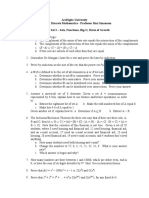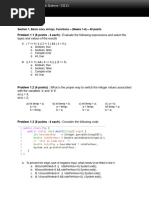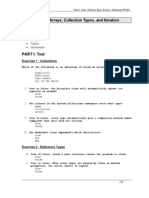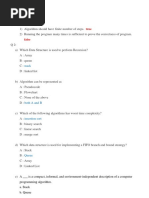Activity4 - SortSearch-Programming Exercises
Uploaded by
Erwin ChenActivity4 - SortSearch-Programming Exercises
Uploaded by
Erwin ChenActivity Sheet – On Search/Sort
Problem #1: Consider this array:
A = [12, 2, 11, 4, 3, 10, -12, 22, 46, 1, 38, 33]:
And using the sort algorithms seen in our lecture slides:
a. Use Quicksort, sort array A in ascending order. List down the values that were chosen as the pivot after each call
of Partition.
b. Use Bubble sort algorithm, sort the array A in ascending order. In the process of sorting the array A, how many
times comparison (i.e., the “if condition” is checked) and swap (i.e., exchanging 2 values) operations were
performed?
c. Referring to insertion sort algorithm and assume that the insertion sort algorithm was modified to sort a set of
values in descending order. Sort the elements in array A. In the process of sorting the array, how many times
comparison and swap operations were performed?
d. Using Selection sort algorithm, sort the array A in ascending order. In the process of sorting the array, how many
times comparison and swap operations were performed?
Problem #2: Discuss/show the situation(s) in which Quicksort exhibits O(n 2).
Problem #3: Discuss/show the situation(s) in which Quicksort yields (nlogn)
Problem #4: Consider the numerical 30-True/False (or Yes or No) Questions game. In this game, Player 1 thinks of a
number in the range 1 to n. Player 2 has to figure out (or guess) this number by asking the fewest number of true/false
(yes or no) questions. Assume that nobody cheats!
a. What is the optimal strategy in finding out Player 1’s number if n is known?
b. What is a good strategy in finding out Player 1’s number if n is not known?
Problem #5: Suppose that you are given a sorted sequence of distinct integers {a1,a2,…,an}. Give an O(lg n) algorithm to
determine whether there exists an i index such as ai=i. For example, in {−10,−3,3,5,7}, a3=3. In {2,3,4,5,6,7}, there is no
such i.
Problem #6: The Grinch is given the job of partitioning 2n players into two teams of n players each. Each player has a
numerical rating that measures how good he/she is at the game. He seeks to divide the players as unfairly as possible,
so as to create the biggest possible talent imbalance between team A and team B. Show how the Grinch can do the job
in O(n log2 n) time.
Problem #7: For each of the following problems, give an algorithm that finds the desired numbers within the given
amount of time.
For the example, S={6,13,19,3,8}, 19−3 maximizes the difference, while 8−6 minimizes the difference.
a. Let S be a sorted array of n integers. Give an algorithm (or write a function) that finds the pair x,y ∈
S that maximizes |x−y|. Your algorithm must run in O(1) worst-case time.
b. Let S be an unsorted array of n integers. Give an algorithm that finds the pair x,y ∈ S that minimizes |x−y|, for x≠y.
Your algorithm must run in O(n lg n) worst-case time.
You might also like
- HW 2 Online Dfadfa Fadmsklfm Mlfmad Mlkfadmf FadNo ratings yetHW 2 Online Dfadfa Fadmsklfm Mlfmad Mlkfadmf Fad4 pages
- Arsdigita University Month 5: Algorithms - Professor Shai Simonson Problem Set 1 - Sorting and SearchingNo ratings yetArsdigita University Month 5: Algorithms - Professor Shai Simonson Problem Set 1 - Sorting and Searching3 pages
- Content of Lab. Manual Prepared by Prof. Anil Kumar SwainNo ratings yetContent of Lab. Manual Prepared by Prof. Anil Kumar Swain6 pages
- CAT1 (Design and Analysis of Algorithms)No ratings yetCAT1 (Design and Analysis of Algorithms)6 pages
- Arsdigita University Month 2: Discrete Mathematics - Professor Shai Simonson Problem Set 2 - Sets, Functions, Big-O, Rates of GrowthNo ratings yetArsdigita University Month 2: Discrete Mathematics - Professor Shai Simonson Problem Set 2 - Sets, Functions, Big-O, Rates of Growth3 pages
- CSCE 210 Dr. Amr Goneid Exercises (7) Sorting AlgorithmsNo ratings yetCSCE 210 Dr. Amr Goneid Exercises (7) Sorting Algorithms3 pages
- Second Exam 2022 - 2023 (W - Solutions) - V1No ratings yetSecond Exam 2022 - 2023 (W - Solutions) - V18 pages
- National Institute of Technology RourkelaNo ratings yetNational Institute of Technology Rourkela2 pages
- KE36903 Numerical Methods Assignment 1: Question No. 1No ratings yetKE36903 Numerical Methods Assignment 1: Question No. 13 pages
- Test 1: CPS 100: Owen Astrachan October 1, 2004No ratings yetTest 1: CPS 100: Owen Astrachan October 1, 200414 pages
- Design & Analysis of Algorithms Mcs 031 Assignment FreeNo ratings yetDesign & Analysis of Algorithms Mcs 031 Assignment Free15 pages
- Qualcomm Atheros QCNFA335: Product NameNo ratings yetQualcomm Atheros QCNFA335: Product Name55 pages
- Detailed Command Line Switches: Options Ordered by FeatureNo ratings yetDetailed Command Line Switches: Options Ordered by Feature11 pages
- Managerial Economics & Business StrategyNo ratings yetManagerial Economics & Business Strategy17 pages
- Lsm9Ds1: iNEMO Inertial Module: 3D Accelerometer, 3D Gyroscope, 3D MagnetometerNo ratings yetLsm9Ds1: iNEMO Inertial Module: 3D Accelerometer, 3D Gyroscope, 3D Magnetometer72 pages
- The Impact of Technological Advancements On Philippine SocietyNo ratings yetThe Impact of Technological Advancements On Philippine Society2 pages
- Effect Inverters On AC Motor Bearing Currents and Shaft VoltagesNo ratings yetEffect Inverters On AC Motor Bearing Currents and Shaft Voltages10 pages
- 2016 10 Social Science Sample Paper Sa2 02No ratings yet2016 10 Social Science Sample Paper Sa2 023 pages
- Exp#5: Bipolar Junction Transistor (BJT) DC Characteristics: Eng. Mariam AlfadhliNo ratings yetExp#5: Bipolar Junction Transistor (BJT) DC Characteristics: Eng. Mariam Alfadhli9 pages
- 4 Semester Syllabus BTECH - CSE - 13.03No ratings yet4 Semester Syllabus BTECH - CSE - 13.0361 pages

























































































